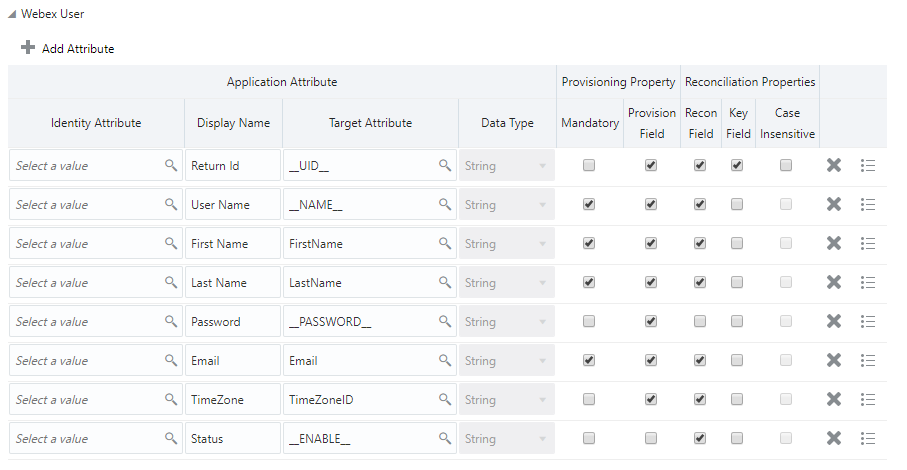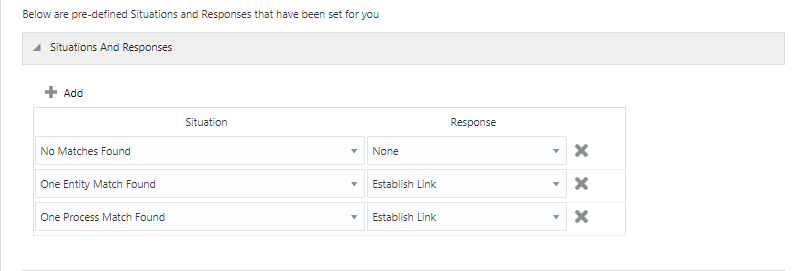3 Configuring the WebEx Connector
While creating an application, you must configure connection-related parameters that the connector uses to connect Oracle Identity Governance with your target system and perform connector operations. In addition, you can view and edit attribute mappings between the process form fields in Oracle Identity Governance and target system columns, predefined correlation rules, situations and responses, and reconciliation jobs.
Basic Configuration Parameters
These are the connection-related parameters that Oracle Identity Governance requires to connect to the WebEx Target application.
Table 3-1 Basic Configuration Parameters for the WebEx Connector
| Parameter | Mandatory? | Description |
|---|---|---|
|
webexID |
Yes |
Enter the Administrator ID for logging in to the WebEx application. |
|
password |
Yes |
Enter the Admin password of the account for logging in to the WebEx application. Sample value: |
|
partnerID |
Yes |
Enter the partner identification generated for the admin user. See Configuring the Target System for more information on obtaining the partnerID. Sample value: |
|
siteID |
Yes |
Enter the Site ID generated for the Admin user. See Configuring the Target System for more information on obtaining the siteID. Sample value: |
|
siteUrl |
Yes |
Enter the Site URL or the WebEx end point URL. Sample value: |
|
Connector Server Name |
No |
By default, this field is blank. If you are using this connector with the Java Connector Server, then provide the name of Connector Server IT Resource here. |
|
proxyHost |
No |
Enter the name of the proxy host used to connect to an external target. Sample value: |
|
proxyPort |
No |
Enter the proxy port number. Sample value: |
|
proxyUsername |
No |
Enter the proxy user name of the target system user account that Oracle Identity Governance uses to connect to the target system. |
|
proxyPassword |
No |
Enter the password of the proxy user ID of the target system user account that Oracle Identity Governance uses to connect to the target system. |
Advanced Settings Parameters
These are the configuration-related entries that the connector uses during reconciliation and provisioning operations.
Note:
Unless specified, do not modify entries in the below table.Table 3-2 Advanced Settings Parameters for the WebEx Connector
| Parameter | Mandatory? | Description |
|---|---|---|
|
Bundle Version |
No |
This entry holds the version of the connector bundle. Default value: |
|
Bundle Name |
No |
This entry holds the name of the connector bundle. Default value: |
|
Connector Name |
No |
This entry holds the name of the connector class. Default value: |
|
startFrom |
No |
Enter the number to start from. Default value: |
|
maximumNum |
No |
Enter the number of records in each batch that must be fetched from the target system during a reconciliation run. Default value: |
|
meetingCenter |
Yes |
This parameter holds the Index values of Service Type Webex Meetings. Default value: 0 Sample value for session codes AUO and PRO: 16,113 |
|
trainingCenter |
Yes |
This parameter holds the Index values of Service Type Webex Training. Default value: 0 Sample value for session codes TRS: 128 |
|
eventCenter |
Yes |
This parameter holds the Index values of Service Type Webex Events. Default value: 0 Sample value for session codes ONS: 129 |
|
supportCenter |
Yes |
This parameter holds the Index values of Service Type Webex Support. Default value: 0 Sample value for session codes SC3: 13 |
Note:
For Index values of Webex Service Types, login to Webex site administrative console, and navigate to Site Information.
Attribute Mappings
The schema page for a target application displays the default schema (provided by the connector) that maps Oracle Identity Governance attributes to target system columns. The connector uses these mappings during reconciliation and provisioning operations.
WebEx User Account Attributes
Table 3-3 lists the user-specific attribute mappings between the process form fields in Oracle Identity Governance and WebEx application columns.
If required, you can edit the default attribute mappings by adding new attributes or deleting existing attributes as described in Creating a Target Application of Oracle Fusion Middleware Performing Self Service Tasks with Oracle Identity Governance.
Table 3-3 Default Attribute Mappings for WebEx User Account
| Display Name | Target Attribute | Data Type | Mandatory Provisioning Property? | Provision Field? | Recon Field? | Key Field? | Case Insensitive? |
|---|---|---|---|---|---|---|---|
|
Return Id |
__UID__ |
String |
No |
Yes |
Yes |
Yes |
No |
|
User Name |
__NAME__ |
String |
Yes |
Yes |
Yes |
No |
No |
|
First Name |
FirstName |
String |
Yes |
Yes |
Yes |
No |
No |
|
Last Name |
LastName |
String |
Yes |
Yes |
Yes |
No |
No |
|
|
|
String |
Yes |
Yes |
Yes |
No |
No |
|
TimeZone |
TimeZoneID |
String |
No |
Yes |
Yes |
No |
No |
|
Status |
__ENABLE__ |
String |
No |
No |
Yes |
No |
No |
|
Password |
__PASSWORD__ |
String |
No |
Yes |
No |
No |
No |
Figure 3-1 Default Attribute Mappings for WebEx User Account

Description of "Figure 3-1 Default Attribute Mappings for WebEx User Account "
Meeting Types Attributes
Table 3-4 lists the Meeting Types-specific attribute mappings between the process form fields in Oracle Identity Governance and Webex target application attributes. The table lists whether or not a given attribute is mandatory during provisioning. It also lists whether a given attribute is used during reconciliation and whether it is a matching key field for fetching records during reconciliation.
If required, you can edit the default attribute mappings by adding new attributes or deleting existing attributes, as described in Creating a Target Application in Oracle Fusion Middleware Performing Self Service Tasks with Oracle Identity Governance.
Table 3-4 Default Attribute Mappings for Meeting Types
| Display Name | Target Attribute | Data Type | Mandatory Provisioning Property? | Recon Field? | Key Field? | Case Insensitive? |
|---|---|---|---|---|---|---|
|
MeetingTypes |
meetingtype~__MEETINGTYPES__~MeetingTypes.MeetingType |
String |
No |
Yes |
Yes |
No |
Figure 3-2 shows the default Meeting Types mapping.
Figure 3-2 Default Attribute Mappings for Meeting Types

Description of "Figure 3-2 Default Attribute Mappings for Meeting Types"
Rules, Situations, and Responses
Learn about the predefined rules, responses and situations for the WebEx application. The connector use these rules and responses for performing reconciliation.
Predefined Identity Correlation Rules
By default, the WebEx connector provides a simple correlation rule when you create a target application. The connector uses this correlation rule to compare the entries in Oracle Identity Governance repository and the target system repository, determine the difference between the two repositories, and apply the latest changes to Oracle Identity Governance.
Table 3-5 Predefined Identity Correlation Rule for a WebEx Target Application
| Target Attribute | Element Operator | Identity Attribute | Case Sensitive? | Rule Operator |
|---|---|---|---|---|
|
__NAME__ |
Equals |
User Login |
No |
AND |
-
__NAME__ is a single-valued attribute on the target system that identifies the user account.
-
User Login is the field on the OIG User form.
-
Rule Operator is AND
Figure 3-3 shows the simple correlation rule for the WebEx connector.
Figure 3-3 Predefined Identity Correlation Rules

Description of "Figure 3-3 Predefined Identity Correlation Rules"
Predefined Situations and Responses
The WebEx connector provides a default set of situations and responses when you create a Target application. These situations and responses specify the action that Oracle Identity Governance must take based on the result of a reconciliation event.
Table 3-5 lists the default situations and responses for the WebEx connector. If required, you can edit these default situations and responses or add new ones. For more information about adding or editing situations and responses, see Creating a Target Application in Oracle Fusion Middleware Performing Self Service Tasks with Oracle Identity Governance
Table 3-6 Predefined Situations and Responses for a WebEx Target Application
| Situation | Response |
|---|---|
|
No Matches Found |
None |
|
One Entity Match Found |
Establish Link |
|
One Process Match Found |
Establish Link |
shows the default situations and responses for the WebEx connector.
Figure 3-4 Default Situations and Responses

Description of "Figure 3-4 Default Situations and Responses"
Reconciliation Jobs
These are the reconciliation jobs that are automatically created in Oracle Identity Governance after you create the application.
Full User Reconciliation Job
You must specify values for the attributes of user reconciliation scheduled jobs.
The WebEx User Reconciliation job is used to fetch all user records from the target system.
You can either use these predefined jobs or edit them to meet your requirements. Alternatively, you can create custom reconciliation jobs. For information about editing these predefined jobs or creating new ones, see Updating Reconciliation Jobs in Oracle Fusion Middleware Performing Self Service Tasks with Oracle Identity Governance.
Table 3-7 describes the parameters of the WebEx User Reconciliation job.
Table 3-7 Parameters of the WebEx User Reconciliation Job
| Attribute | Description |
|---|---|
|
Application Name |
Name of the application you created for your target system. This value is the same as the value that you provided for the Application Name field while creating your target application. Do not modify this value. |
|
Filter |
Enter the search filter for fetching records from the target system during a reconciliation run. Sample value: See Performing Limited Reconciliation for more information about filtered reconciliation. |
|
Batch Size |
Enter the number of batches to be reconciled. Default value: |
|
No. of Batches |
Type of object you want to reconcile. Default value: |
|
Batch Start Index |
Enter the Batch start index from which point the user reconciliation has to start. Default value: |
|
Object Type |
Type of object you want to reconcile. Default value: |
Reconciliation Jobs for Lookup Field Synchronization
These lookup definitions are used as an input source for lookup fields in Oracle Identity Governance.
The Webex Timezone Lookup Reconciliation Scheduled job is used to fetch data about time zones during target resource reconciliation.
Table 3-8 describes the parameters of the Webex Timezone Lookup Reconciliation Scheduled job.
Table 3-8 Parameters of the Webex Timezone Lookup Reconciliation Scheduled Job
| Attribute | Description |
|---|---|
|
Application Name |
Name of the application you created for your target system. This value is the same as the value that you provided for the Application Name field while creating your target application. Do not modify this value. |
|
Code Key Attribute |
Enter the name of the connector attribute that is used to populate the Code Key column of the lookup definition (specified as the value of the Lookup Name attribute).
Default value: __UID__ |
|
Decode Attribute |
Enter the name of the connector attribute that is used to populate the Decode column of the lookup definition (specified as the value of the Lookup Name attribute).
Default value :__NAME__ |
|
Lookup Name |
Enter the name of the lookup definition in Oracle Identity Governance that must be populated with values fetched from the target system. Default value :Lookup.Webex.TimeZones |
|
Object Type |
Enter the type of object whose values must be synchronized. Default value :timeZones |